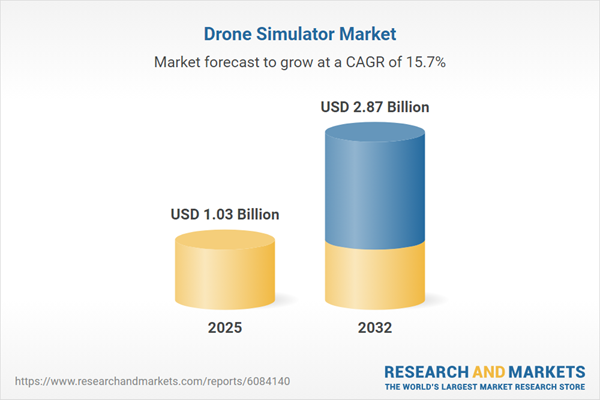Speak directly to the analyst to clarify any post sales queries you may have.
The global drone simulator market is rapidly evolving, transforming how organizations approach aviation training, mission rehearsal, and technology innovation. Senior decision-makers across sectors are leveraging advanced simulation solutions to boost operational excellence and support increasingly complex training demands.
Market Snapshot: Drone Simulator Market Size and Growth Potential
The Drone Simulator Market is experiencing robust expansion, rising from USD 896.74 million in 2024 to USD 1.03 billion in 2025 and projected to reach USD 2.87 billion by 2032 with a CAGR of 15.67%. Growth is fueled by rising demand from pilot training centers, prominent military organizations, and a surge in commercial drone applications. These drivers underscore the industry's need for advanced, high-fidelity simulation platforms that enable realistic training experiences while reducing operational costs. Senior leaders are increasingly prioritizing investments in simulation as they seek scalable, technology-driven solutions to support pilot development and organizational readiness.
Scope & Segmentation
This report provides a comprehensive analysis of the global drone simulator industry, capturing strategic shifts in technology integration, training approaches, and solution delivery models. Segmentation spans product types, technologies, use cases, user categories, and geographic markets to help senior leaders understand where technological advancements translate into business value. Key segments include:
- Product Types: Fixed wing simulators; Rotary wing simulators.
- Technologies: Hardware in the loop solutions; Software in the loop platforms.
- Applications: Commercial operations; Military training; Pilot training programs; Research and development uses.
- Drone Types: Commercial drone simulators; Consumer drone simulators; Military drone platforms.
- Delivery Modes: Cloud-based solutions, including private and public models; Desktop-based environments, both console and PC; Virtual reality-based modules, spanning fully immersive and semi-immersive experiences.
- End Users: Academic institutions; Flight schools; Military organizations; UAV manufacturers.
- Regional Coverage: Americas (United States, Canada, Mexico, Brazil, Argentina, Chile, Colombia, Peru); EMEA (Europe, Middle East, Africa: UK, Germany, France, UAE, Saudi Arabia, South Africa, Nigeria, Egypt); Asia-Pacific (China, India, Japan, Australia, South Korea, Indonesia, Thailand, Malaysia, Singapore, Taiwan).
- Leading Companies: CAE Inc.; Lockheed Martin Corporation; The Boeing Company; Raytheon Technologies; L3Harris Technologies; Leonardo S.p.A; General Atomics Aeronautical Systems; Elbit Systems; DroneSimPro Inc.; Aero Simulation Technologies Pvt. Ltd.
Key Takeaways: Strategic Insights for Senior Decision-Makers
- Industry momentum reflects increasing demand for scenario-based simulation, directly improving pilot proficiency, risk management, and cost control.
- Stakeholders rely on integrated hardware and software simulation tools, enabling tactile feedback and rapid scenario customization within both training and R&D cycles.
- Immersive virtual reality technologies, both semi- and fully immersive, are closing the gap between virtual and real-world flying for improved outcomes and lower resource utilization.
- Cloud-based delivery is streamlining operations, allowing remote collaboration, the creation of global training libraries, and the development of distributed learning networks.
- Simulation advances are supporting organizational sustainability goals by reducing the environmental impact associated with traditional in-aircraft training.
Tariff Impact: Navigating Policy Change and Cost Structure
The 2025 introduction of United States tariffs on imported simulation components has significantly affected cost structures within the drone simulator market. Organizations are responding by localizing manufacturing, forging stronger partnerships with regional suppliers, and moving toward software-centric and cloud-hosted training platforms. These adjustments help maintain curriculum continuity and improve resilience, even as delivery timelines and supply chain strategies shift in response to policy developments.
Methodology & Data Sources
This report draws on extensive engagement with leading industry stakeholders, including interviews with product managers, training directors, defense officials, and academic researchers. Data is corroborated through cross-referencing regulatory filings, technical white papers, and vendor disclosures to ensure a balanced and insightful analysis.
Why This Report Matters
- Delivers actionable intelligence to help decision-makers align investments in drone simulator technology with dynamic operational and regulatory requirements.
- Includes segmented analysis by region and end-user, supporting the development of targeted go-to-market strategies and enabling leaders to capitalize on emerging opportunities in simulation, training, and mission rehearsal.
Conclusion
The drone simulator market presents organizations with reliable and technology-forward training solutions poised to support evolving operational objectives and sustainability commitments. Leveraging these insights helps drive competitive advantage and ensures preparedness within a fast-changing global industry.
Table of Contents
3. Executive Summary
4. Market Overview
7. Cumulative Impact of Artificial Intelligence 2025
Companies Mentioned
The companies profiled in this Drone Simulator market report include:- CAE Inc.
- Lockheed Martin Corporation
- The Boeing Company
- Raytheon Technologies Corporation
- L3Harris Technologies, Inc.
- Leonardo S.p.A
- General Atomics Aeronautical Systems, Inc.
- Elbit Systems Ltd.
- DroneSimPro Inc.
- Aero Simulation Technologies Pvt. Ltd.
Table Information
| Report Attribute | Details |
|---|---|
| No. of Pages | 199 |
| Published | November 2025 |
| Forecast Period | 2025 - 2032 |
| Estimated Market Value ( USD | $ 1.03 Billion |
| Forecasted Market Value ( USD | $ 2.87 Billion |
| Compound Annual Growth Rate | 15.6% |
| Regions Covered | Global |
| No. of Companies Mentioned | 11 |









